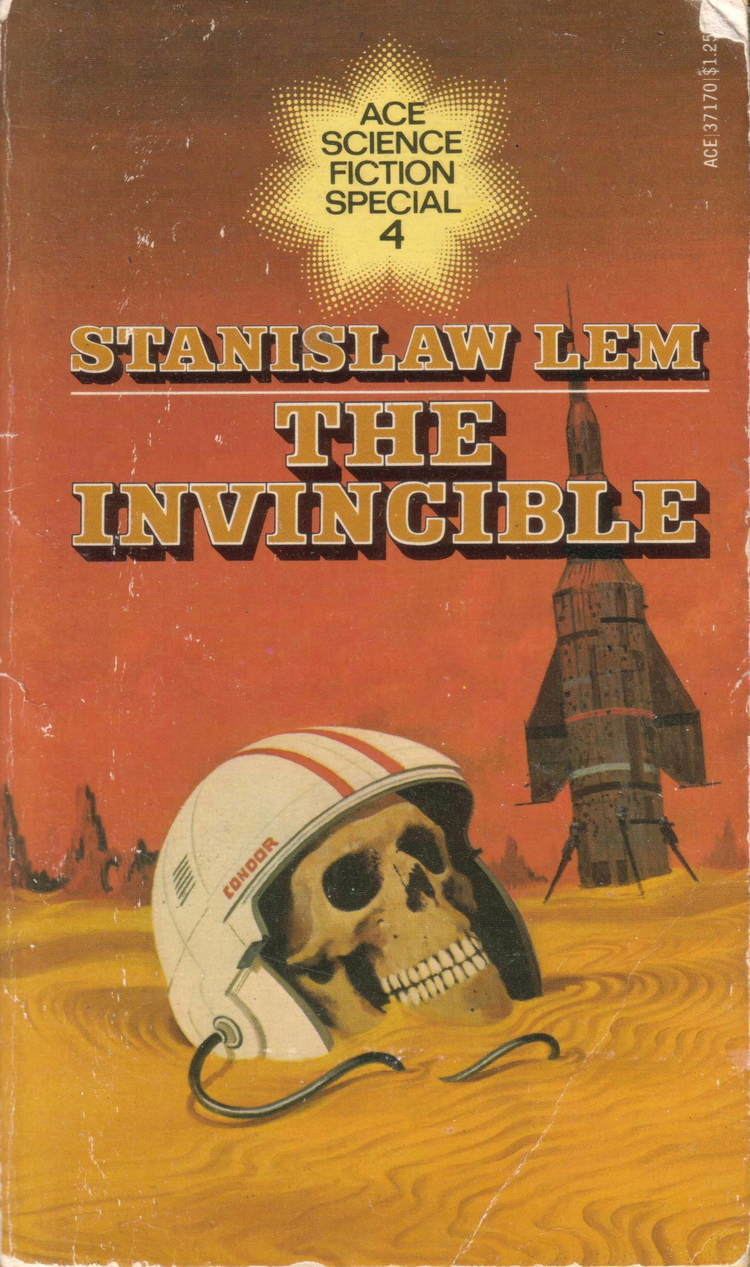8.4 /10 1 Votes8.4
Cover artist Piotr Borowy Published in English 1973 | 4.2/5 Goodreads Publication date 1964 Originally published 1964 Genre Hard science fiction Published in english 1973 | |||||||||||||||||||||||||||||||||
 | ||||||||||||||||||||||||||||||||||
Pages 316 pp (first edition, paperback) OCLC 488362 (English-language edition) Similar Solaris, Eden, Return from the Stars, Tales of Pirx the Pilot, The Cyberiad | ||||||||||||||||||||||||||||||||||
The Invincible (Polish: Niezwyciężony) is a science fiction novel written by Stanisław Lem and published in 1964.
Contents
The Invincible originally appeared as the title story in Lem's collection Niezwyciężony i inne opowiadania ("The Invincible and Other Stories"). A translation into German was published in 1967; an English translation by Wendayne Ackerman of the German translation was published in 1973.
It was one of the first novels to explore the ideas of microrobots, artificial swarm intelligence and "necroevolution", a term suggested by Lem for evolution of non-living matter.
Plot summary
A very powerful and armed interstellar space ship called Invincible lands on the planet Regis III which seems uninhabited and bleak, to investigate the loss of its sister ship, Condor. During the investigation, the crew finds evidence of a form of quasi-life, born through evolution of autonomous, self-replicating machines, apparently left behind by an alien civilization which had inhabited the planet a very long time ago.
The protagonists come to speculate that evidently a kind of evolution must have taken place under the selection pressures of "robot wars", with the only surviving form being swarms of minuscule, insect-like micromachines. Individually, or in small groups, they are quite harmless and capable of only very simple behavior. When they feel threatened, they can assemble into huge clouds, able to travel at a high speed and even to climb to the top of troposphere. These swarms display complex behavior arising from self-organization and can incapacitate any intelligent threat by a powerful surge of electromagnetic interference. Condor's crew suffered a complete memory erasure as a consequence of attacks from these "clouds".
Invincible's crew mounts an escalating series of attacks on the perceived enemy, but eventually recognizes the futility of their efforts in the most direct sense of the word. The robotic "fauna", dubbed necrosphere, has become part of the planet's ecology, and would require a disruption on a planetary scale (such as a nuclear winter) to be destroyed.
The novel turns into an analysis of the relationship between different life domains, and their place in the universe. In particular, it is an imaginary experiment to demonstrate that evolution may not necessarily lead to dominance by intellectually superior life forms. The plot also involves a philosophical dilemma, juxtaposing the values of humanity and the efficiency of mechanical insects.
In the face of defeat and imminent withdrawal of the Invincible, Rohan, the spaceship's first navigator, undertakes a trip into the "enemy area" in search of four crew members who went missing in action – an attempt which he and the Invincible's commander see as certainly futile, but necessary for moral reasons. Rohan wanders into canyons covered by metallic "shrubs" and "insects" and finds some of the missing crewmen dead. He gathers some evidence and returns to the ship unharmed thanks partially to a device which somewhat cloaks the electrical activity of his brain, and partially to his calm and unthreatening behavior.
Reception
Theodore Sturgeon praised The Invincible as "sf in the grand tradition," saying "The Science is hard. The descriptions are vivid and powerful."
